-
Key Takeaways
-
What Is Aircraft Icing and Why Is It Dangerous?
- Additional Dangers of Ice Accumulation
-
Different Types of Icing in Aviation
- Clear Ice
- Rime Ice
- Mixed Ice
- Frost
-
When Does Icing Occur in Aviation?
- Icing Risks in Stratiform Clouds
- Freezing Rain and High-Altitude Clouds
-
What Is Induction Icing?
- Preventing and Managing Induction Icing
-
What To Do with Aircraft Icing
- Ice Mitigation Strategies In-Flight
-
Conclusion
If ice starts building up on your aircraft, you’re looking at a serious problem. Ice can affect everything from how the airplane flies to the engines staying functional.
And ice doesn’t just make things slippery, it messes with the airflow over the wings, cuts down on lift, and ramps up drag.
If you’re flying in the wrong conditions without being prepared, that buildup could lead to serious trouble.
There are different types of icing you will need to know about, each with its own risks.
In this article, we’ll explain the hazards of aircraft icing and you’ll learn what you can do to stay ahead of icing.
Key Takeaways
- Icing occurs when water droplets freeze on your aircraft in cold, moist conditions.
- There are different types of icing: clear ice, rime ice, mixed ice, and frost.
- Induction icing can block airflow in the engine, leading to power loss.
- You can solve icing by using de-icing systems and avoiding known icing conditions.
What Is Aircraft Icing and Why Is It Dangerous?
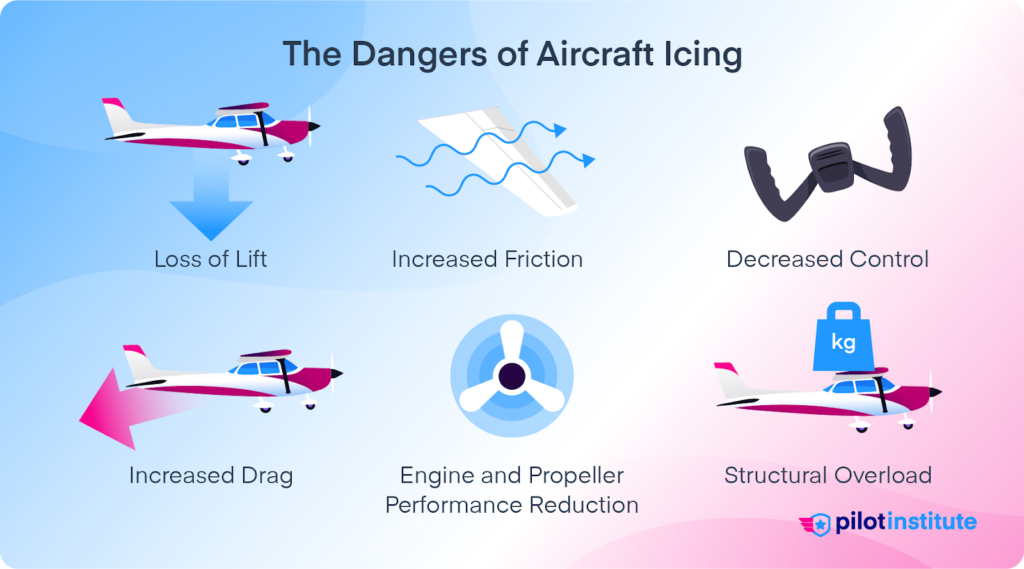
How does ice get on your aircraft in the first place?
Well, two conditions are always present in icing:
- There is visible moisture, such as clouds or water droplets.
- The temperature is at or below freezing (0°C or 32°F).
Together, they form a dangerous combination. These droplets freeze instantly when they hit the airframe. If you don’t act quickly, you’ll soon feel its effects.
Remember that wings, propeller blades, and tail surfaces are airfoil-shaped. They’re designed with precision to utilize the airflow around these surfaces.
Ice build-up on the airframe changes the airflow pattern around these airfoils. This leads to a serious loss of lift and an increase in drag.
On top of that, it will also worsen the skin friction between the air and your aircraft’s structure.
Ice, snow, or frost is thick and rough, like coarse sandpaper. This roughness adds to friction drag, which can reduce lift and increase drag by as much as 50% on a wing’s leading edge and upper surface.
With thicker accumulations and irregular shapes, drag can get up to two times worse!
Additional Dangers of Ice Accumulation
Icing also makes your aircraft heavier and can even change the position of the center of gravity.
When ice forms on control surfaces and the propeller, it can cause these components to become unbalanced. This leads to severe vibrations and difficulty controlling the aircraft.
Icing doesn’t just affect the wings and control surfaces. It can also disrupt sensors needed for flight safety, like the pitot tubes.
If ice blocks a pitot tube, your aircraft’s instruments will provide inaccurate airspeed readings. This might cause you to make dangerous adjustments.
This kind of failure has already led to many accidents in the past. This is why the danger of icing cannot be understated.
Most aircraft are equipped with a pitot heater to prevent icing in the pitot tube. It’s essential to turn on the pitot heat whenever there is a chance of icing, especially in cold or moist conditions or when flying through clouds.
Worst of all, is that icing can bring your aircraft to complete engine failure. If ice blocks the engine air intake in subzero temperatures or carburetor ice forms in moist air up to 25°C or 80°F, you’re in danger of losing partial or even total engine power.
Different Types of Icing in Aviation
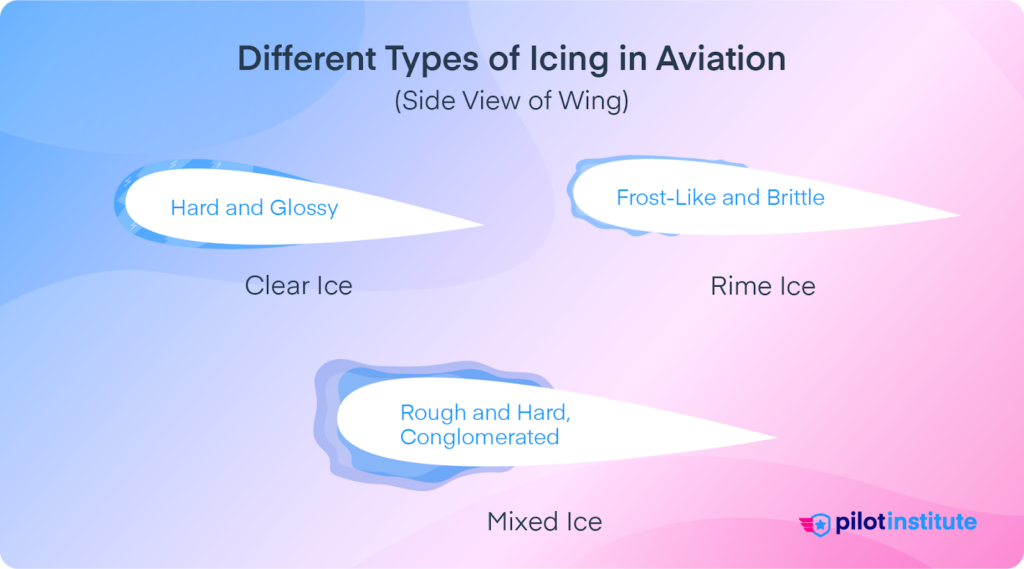
Did you know there’s more than just one type of aircraft icing? In fact, there are at least four, and they can each disrupt your flight differently.
Clear Ice
Clear ice, also known as rain ice, is the most dangerous type of icing that can form on your aircraft.
It usually happens when you’re flying through freezing rain, where raindrops spread out and freeze upon hitting the cold surface of your airplane. This type forms when drops are large, such as in rain or cumuliform clouds.
The appearance of ice pellets is a sign that freezing rain might be present at higher altitudes. These are formed when rain falls from warmer air and freezes as it passes through colder air on the way down.
On the other hand, if you see wet snow, it means the temperatures higher up are subzero, but the air at your current altitude is warmer, causing the snow to melt as it reaches you.
Even though water normally freezes at 0°C or 32°F, liquid water can still exist in temperatures as low as -20°C (4°F) or colder. These supercooled water droplets are unstable and freeze when they touch a cold surface, like the airplane’s skin or propeller blades.
The freezing happens slowly, because the heat released in the process lets some of the water spread backward before solidifying.
The slower the freezing, the more the water spreads. This results in a smooth, clear sheet of ice with little trapped air.
Clear ice is heavy and smooth, sometimes forming lumps, and it sticks firmly to surfaces. If it breaks off, it can fall off in large chunks, which can cause even more damage.
Clear ice changes the shape of the wings and other vital parts, making them less effective. This, combined with the extra weight, can seriously threaten your safety.
Rime Ice
You’re most likely to encounter rime ice forms when you’re flying in stratified clouds or a light drizzle.
Tiny, supercooled water droplets can freeze instantly upon hitting a surface that’s below freezing. And what do you get when that happens?
Well, since the droplets are so small, there’s not enough water after freezing to form a smooth, solid layer. Instead, you get a rough, cloudy deposit of tiny ice particles and trapped air, called rime ice.
This type of icing commonly occurs in colder temperatures, between -10°C (14°F) to -20°C. At these lower temperatures, the supercooled droplets are much smaller and freeze instantly upon contact, trapping air and creating a rough, cloudy layer of ice.
Because rime ice forms quickly and has a rough texture, it tends to build up in these forward-facing surfaces that are directly exposed to the oncoming airflow. It most commonly forms on the leading edges of your aircraft, including the wings, tail, and horizontal stabilizer, as well as on the propeller blades and pitot tubes.
Rime ice affects the aerodynamics of the aircraft by disrupting airflow over the wings or into the engine, though it doesn’t add as much weight as clear ice.
Mixed Ice
The worst-case scenario, however, is when you get both clear ice and rime ice at the same time. Fittingly, this is called mixed ice.
You get mixed ice when both small supercooled water droplets and larger raindrops or ice particles hit an aircraft surface and freeze upon contact. This creates a combination of rime ice (rough and brittle) and clear ice (smooth and hard). The result is an uneven, lumpy ice layer.
Weather conditions that lead to mixed ice include areas where warm air layers are above freezing and cold air layers are below freezing. In these situations, liquid raindrops in the warmer air fall into colder, subzero air layers and freeze when they contact the aircraft’s cold surface.
The presence of different types of precipitation, such as snow, sleet, or freezing rain, all contribute to mixed ice formation.
Mixed ice is particularly dangerous because it combines the worst characteristics of both rime and clear ice.
The uneven, bumpy surface created by mixed ice severely disrupts airflow over the wings and other aerodynamic surfaces, reducing lift and increasing drag. It can also cause control surfaces like ailerons and flaps to function improperly, making the aircraft harder to maneuver.
The mixed ice also adds weight to the aircraft and can affect engine performance by blocking airflow into the engine intakes.
Frost
Have you ever walked up to your aircraft on a cold winter’s day and seen a white coat of ice around it?
This is called frost, and it forms when moist air comes into contact with a surface that’s below freezing. Instead of turning into liquid water, the moisture freezes directly into ice, creating a rough sheet of crystalline ice around your aircraft.
Frost can be tough to scrape off and should always be removed before takeoff.
You can encounter frost when your aircraft is parked in freezing temperatures or when you fly from cold air into warmer, moist air—such as during descent or when climbing through a temperature inversion (where the temperature rises with altitude).
But how dangerous is it? Well, while frost isn’t as dangerous as clear ice, it can still block your view through the cockpit window. It also affects your aircraft’s ability to generate lift, which is a very serious hazard.
Frost doesn’t change the shape of the wing, but it disrupts the smooth airflow, causing the air to separate early from the wing’s surface and reducing lift.
If frost forms on the wings during takeoff, it can interfere with airflow enough to prevent the aircraft from lifting off at its usual speed or even from taking off at all.
When Does Icing Occur in Aviation?
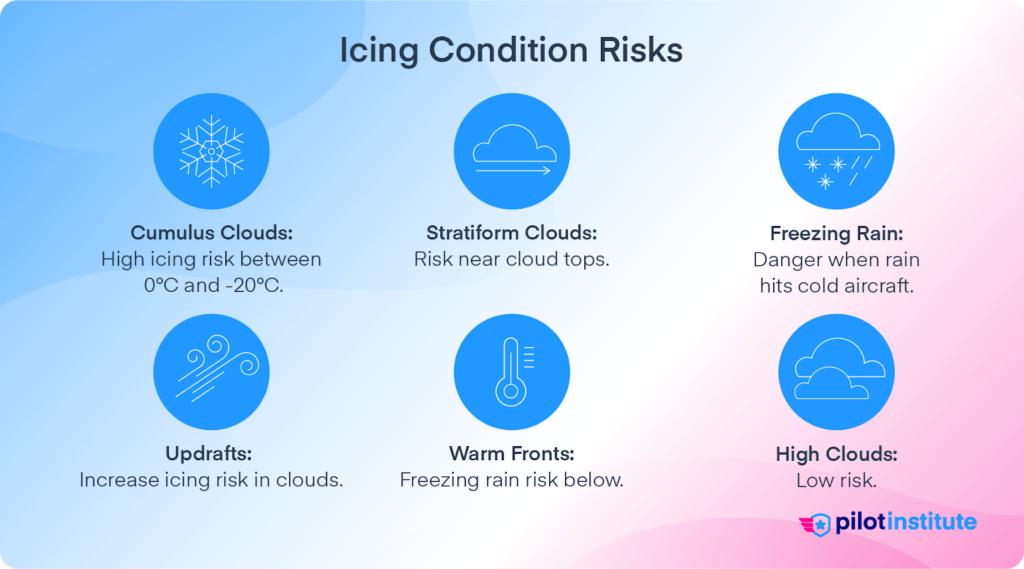
So, when are you most in danger of getting into aircraft icing? Let’s look at some areas and situations you should watch out for.
Cumulus clouds usually have mostly liquid water droplets at temperatures as low as -10°C. If the updrafts in these clouds are strong, the droplets can stay liquid down to -20°C. Any lower, though, the cloud will turn into ice. The “newer” parts of these clouds have more liquid drops than the “older” parts.
You’ll have a very likely chance of getting ice when you’re flying through cumulus clouds between 0°C and -10°C and a moderate to high chance between -10°C and -20°C. The chance of icing drops quickly below -20°C, and it’s very unlikely below -40°C (-40°F).
Because cumulus clouds have a lot of vertical movement, the risk of icing may exist throughout a wide altitude band in and under the clouds. Updrafts can push water droplets higher, making them bigger and increasing the chance of ice formation.
If you do encounter significant icing, you need to descend to warmer air to reduce the risk.
Icing Risks in Stratiform Clouds
Stratiform clouds, on the other hand, are usually made up of liquid water drops down to around -10°C, which means there’s still a risk of icing. If you expect icing, it’s best to fly at a lower altitude where temperatures are above 0°C, or higher up where it’s colder than -10°C.
The highest risk of icing in stratiform clouds is usually near the top. In special conditions, like when stratiform clouds are part of an active front or are pushed up by mountains, the risk of icing can increase at colder temperatures because of the constant upward movement of air, which keeps more liquid water in the cloud.
Freezing Rain and High-Altitude Clouds
If you’re flying through rain or drizzle, the droplets can freeze as they hit the cold surface of your aircraft at temperatures below 0°C. The bigger the raindrops, the higher the chance of dangerous clear ice forming.
Be extra cautious when flying in freezing rain, especially in the colder air under a warm front, where rain falls from warmer air above.
High-altitude clouds, like cirrus clouds, which form above 20,000 feet, are mostly made of ice crystals. These won’t freeze onto your aircraft, so the risk of structural icing in these clouds is very low.
What Is Induction Icing?
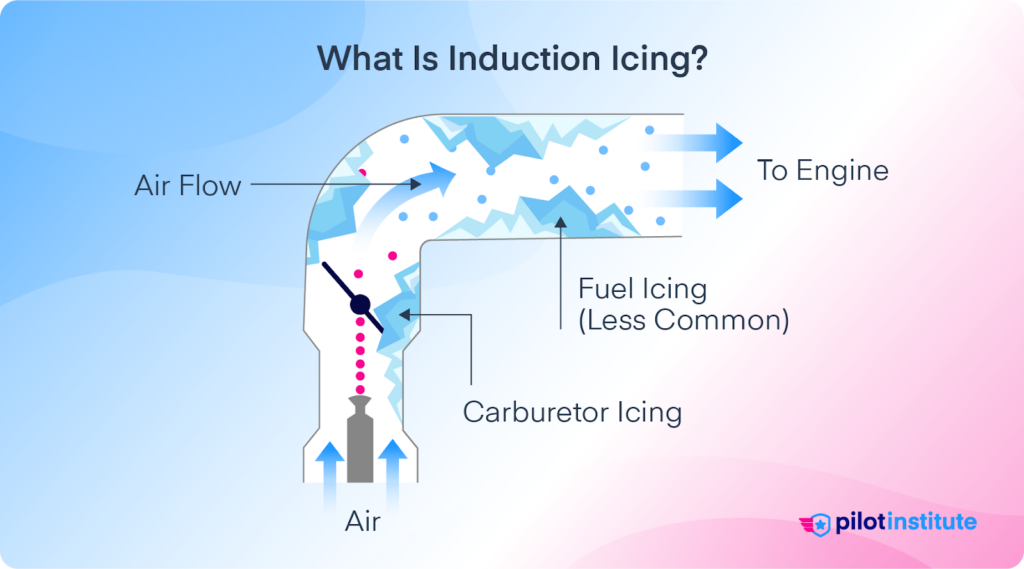
While icing on the wings and control surfaces is a clear threat, not all ice builds up where you can see it. Beyond the wings, there’s another danger: induction icing.
Did you know your engine could freeze up even on a warm, sunny day? When you’re flying in moist air, even at temperatures as warm as 25°C, ice can still form in an engine’s carburetor and induction system.
This happens because air pressure decreases as it flows through the carburetor, which can lower the temperature below freezing, even if the outside air is warm.
When this happens, moisture in the air condenses and freezes, forming ice that can block or reduce the flow of air and fuel into the engine. This ice buildup causes the engine to lose power, run roughly, or, in severe cases, shut down completely.
Preventing and Managing Induction Icing
Most airplanes with carbureted engines have a carburetor heat control. This control allows you to direct hot air around the engine into the carburetor instead of the colder ambient air.
The warm air helps melt any formed ice and prevents further ice buildup. However, using carburetor heat can reduce engine performance slightly because hot air is less dense, meaning less oxygen reaches the engine.
Still, it’s important to use carburetor heat when necessary to avoid more serious problems. The proper use of carburetor heat varies depending on the aircraft, and the correct procedures are spelled out in the Pilot’s Operating Handbook of your aircraft.
Structural icing around the engine air intake can also occur in below-freezing conditions, blocking airflow into the induction system. This can reduce engine performance or, in severe cases, cause the engine to fail.
Your aircraft might have an alternate air system that allows the engine to draw air from a different source, bypassing the blocked intake to keep the engine running.
What To Do with Aircraft Icing
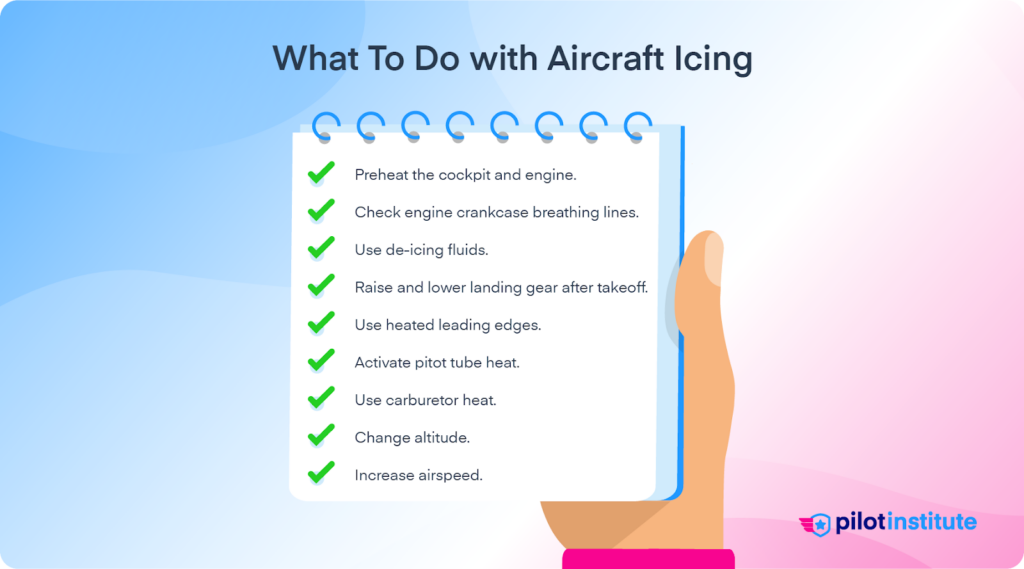
With all its dangers, you should be relieved that icing is still a very preventable problem.
In extremely cold weather, during your preflight, you should check the engine crankcase breathing lines to ensure they aren’t blocked by ice from frozen vapors. It’s also a good idea to preheat the cockpit and engine, so the electronic instruments and engine reach normal temperatures before starting.
You can also use de-icing fluids sprayed onto critical surfaces to lower the freezing point of water and prevent ice buildup.
After starting the engine, the oil pressure will take longer to rise. If it doesn’t rise within 60 seconds, you should shut down the engine.
After taking off from a slushy runway in freezing conditions, consider raising and lowering the landing gear a few times to break off any ice and keep it from freezing in the up position. Follow the manufacturer’s instructions for this procedure.
Ice Mitigation Strategies In-Flight
But if ice does end up on your aircraft, what should you do to fix it?
Many aircraft have heated leading edges on the wings, tail, and propellers. These are often powered by electrical elements or by hot air from the engine to keep the surfaces warm enough to prevent ice from sticking.
The pitot tube, which measures airspeed, is typically equipped with a heating element to prevent ice from blocking it, ensuring accurate instrument readings.
To prevent ice in carbureted engines, carburetor heat warms incoming air to keep ice from forming inside the engine’s induction system, especially at lower power settings.
Icing tends to be more severe in the temperature range from 0°C to -10°C. Climbing to a higher altitude, where the temperature is colder, or descending to warmer air can help reduce or eliminate ice buildup.
Lastly, increasing airspeed can help maintain better control and reduce the rate of ice accumulation. However, be cautious to stay within safe operational speeds for your aircraft.
Conclusion
Ice on the wings, in the engines, or even in the air intake can cause performance problems that are hard to come back from.
Now that you understand what can lead to icing, you can avoid the worst-case scenarios. The next time you’re in icing conditions, remember that preparation is your best tool, and sometimes doing nothing is the biggest risk.



